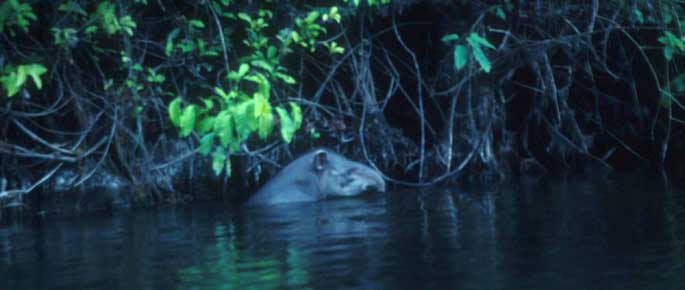


Later in the trip we spent a week at Rio Cristalino in the very heart of the Brazilian Amazon Basin. This is a fabulous lodge along the black-water Rio Cristalino in very wild and undisturbed lowland swamp forest. During boat rides on three days we encountered five tapirs swimming across the river. They would dive when they heard the boat and then reappear long distances away; they can certainly move rapidly under water. The photo above is one of those tapirs; to the right it scrambles up the river bank on our approach.
Tapirs are among the most primitive large mammals in the world today. Macdonald (1984) says
"There were members of the modern genus Tapirus roaming the Northern Hemisphere 20 million years ago and their descendants have changed little. Their scattered relict distribution is often cited as evidence of the existence of the supercontinent of Gondwandaland, on the assumption that tapirs reached their present homes overland before the continents drifted apart."Alas, today they are hunted extensively and threatened by habitat loss. The three additional species are all listed as "Vulnerable" or "Endangered." The most elusive is the Malayan Tapir T. indicus of southeast Asia. It is a large black tapir that looks like it is wearing a bright white diaper, at least in paintings. I don't know anyone who has seen one. In South America the Baird's Tapir T. bairdi is very local and sparse in the lowlands of southern Mexico to Ecuador. The Mountain Tapir T. pinchaque lives in the remote Andean forests from Colombia to Peru.
Tapirs have regular routes through the forest undergrowth and mark their territories with urine and dung, as do rhinos. They walk with their noses to the ground and must rely on scent heavily to detect other tapirs or predators. They are a favored prey of jaguars in the New World, and of tigers and leopards in the Old World. They are themselves entirely vegetarian, but are catholic in their dietary preferences. They both graze and browse.
I have been to remote Amazon Basin villages where a tapir was a pet, caught as a baby and raised by hand, and now wandering around the village feeding on scraps. Wild tapirs are quite wary, though, and it is always a special day when one is actually seen in the wild.
The taxonomy here follows Macdonald, D., ed. (1984) The Encyclopedia of Mammals, 1st ed. Facts on File Publ., New York. Other than personal experiences, the facts are mostly summarized from that text.
PHOTOS: All photos on this page are © 2001 Don Roberson; all rights reserved. The Brazilian Tapir was photographed in the Rio Cristalino of central Brazil in August 1999.